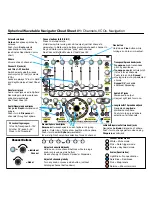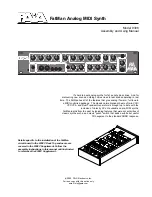
Tips
The DX7s has been designed for years of trouhle-free use. In order to ensure that it
remains a healthy member of your family
of
musical instruments, please keep the
following tips in mind:
Installation:
When setting up the DX7s in your home or studio, avoid exposure to direct sunlight or
other sources of heat. Environments with excessive dust, cold, dampness, or vibration can
also damage your instrument. Even though the DX7s is electronic, you should treat it with
the same kind of care you would lavish on any other musical instrument.
Also, since the DX7s is electronic, you should make sure not to set it too close to
equipment (such as a television set) that generates electromagnetic fields. Such proximity
could cause both malfunctions in the synthesizer’s digital circuitry and interference noise
in the other unit.
Handling:
The DX7s is sturdy, but it can do without rough handling. Don’t subject it to sudden jolts
(such as dropping it), as this can damage the internal circuitry. If you plan to travel with it,
be sure to use a road case. Also, make sure not to apply excessive force to any of the keys,
buttons, or other controls.
Cleaning:
To clean or dust your DX7s, use nothing more than a clean, slightly damp cloth. Using
chemical solvents will damage the finish, and using too much water may do considerable
damage to the internal circuitry.
AC Power & Other Equipment:
When you are using the DX7s with an amplifier or mixer that has unbalanced outputs,
connect both units to the same AC outlet to avoid hum.
If you use a number of electronic instruments in your setup, you may want to consult an
electrician, who can make sure that your system does not overtax the available power.
Summary of Contents for DX7s
Page 1: ...YAMAHA DIGITAL PROGRAMMABLE ALGORITHM SYNTHESIZER OWNER S MANUAL ...
Page 7: ...Playing the DX7s 1 ...
Page 25: ...Creating and Storing New Sounds 19 ...
Page 34: ... 28 ...
Page 35: ...Using the New Performance Features 29 ...
Page 38: ...Button 29 LCD Displays 32 ...
Page 45: ...Entering the Micro Tuning Edit Mode Editing Micro Tuning Data Storing Micro Tuning Data 39 ...
Page 46: ... 40 ...
Page 47: ...Using the New Voice Features 41 ...
Page 51: ...Button 10 LCD Displays 45 ...
Page 64: ...Editing Fractional Scaling Data Storing Fractional Scaling Data 58 ...
Page 65: ...Memory Functions 59 ...
Page 68: ...Button 14 LCD Displays 62 ...
Page 69: ... 63 ...
Page 76: ...Formatting a RAM Cartridge Loading Voice Performance Data from a RAM Cartridge 70 ...
Page 77: ...MIDI Functions 71 ...
Page 80: ...Button 32 LCD Displays 74 ...
Page 85: ...Appendices 79 ...
Page 89: ......
Page 90: ...MIDI DATA FORMAT 1 Transmission Requirements Add 1 ...





































